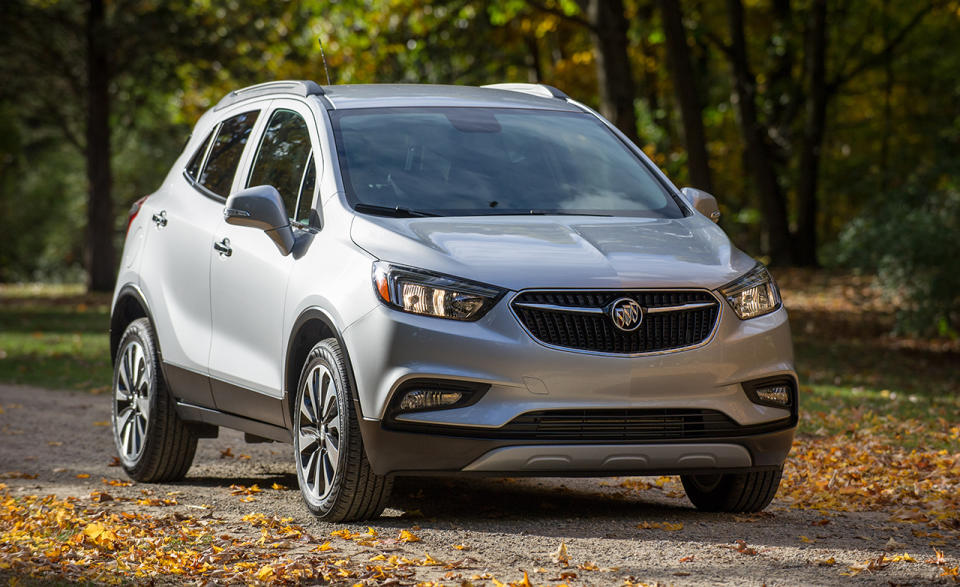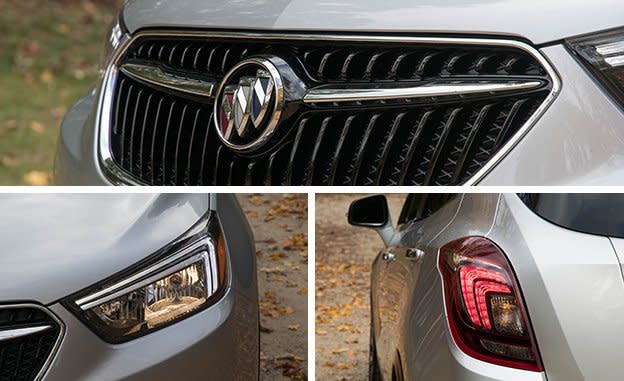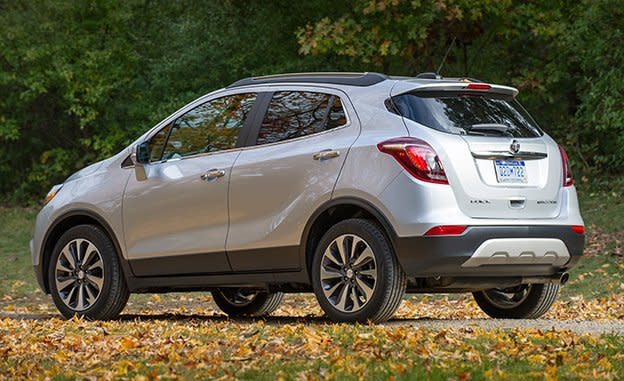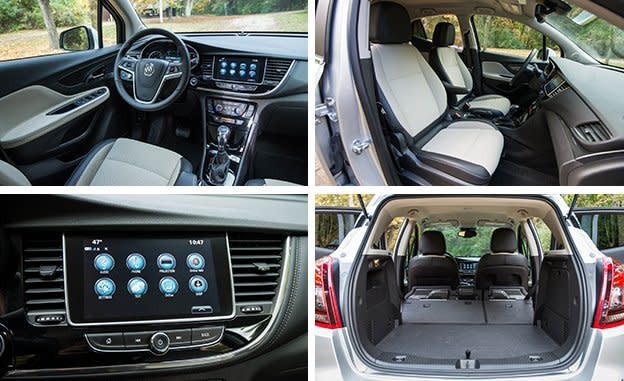2017 Buick Encore 1.4L Turbo FWD

In nearly every one of our reviews of Buick’s tiny Encore since the subcompact crossover went on sale in 2013, we’ve called out its remarkable resemblance to a shiny potato. There, we did it again, but now that the Encore has been refreshed for 2017, dare we rename it a sweet potato? That’s because the cumulative effects of the changes enhance the appeal that has already made the Encore Buick’s best-selling model.
The Encore’s Encore
If you’re having trouble grasping how Buick sold more than 67,000 Encores last year—more than its three immediate subcompact luxury-crossover competitors combined, the larger BMW X1, Audi Q3, and Mercedes-Benz GLA-class—it’s not that hard. The Buick has an attractive, $23,915 base price; it’s undeniably cute; the seating position is high; and the view out of the windshield panoramic. While the Encore’s size and price likely disqualify it as a real competitor to a Mercedes or BMW, the interior—particularly in its refreshed state—is of high quality, and the overall execution is a step above run-of-the-mill subcompact crossovers.

Buick has added a few creases and edges to the Encore’s rotund body for 2017, squaring up the front end with blockier headlights and its new corporate waterfall grille. Subtle updates to the rear amount to little more than revised taillights. That’s all standard refresh stuff, though. What really does the heavy lifting in elevating the Encore’s luxury pretensions is an all-new dashboard with soft-touch materials and a more sweeping design. It looks vastly better than the old, upright dash. The previous clutter of buttons and the fiddly, knob-operated central display is gone, too, replaced by a high-resolution 8.0-inch touchscreen. Embedding this infotainment screen in the dash itself instead of in a pod on top also clears the way for an even more expansive view through the windshield.
A Better Engine
The most notable change for 2017 is the expanded availability of the higher-output, 153-hp 1.4-liter turbo four-cylinder engine introduced last year to the mid-level Sport Touring trim. The more powerful engine boasts direct fuel injection and is now an $895 option on the Sport Touring, as well as the Preferred II, Essence, and Premium trims. A 138-hp, turbo four (also displacing 1.4 liters but of an older, port-injected design) remains standard across the board. Shooting past the $23,915 Encore 1SV and the Encore Preferred to the Sport Touring trim with the optional powerplant costs $27,395, or $1275 less than last year’s Encore Sport Touring.

The Preferred II example tested here begins at $27,760. The more powerful engine and one other option, $395 Quicksilver Metallic paint, brought its MSRP to $29,080. We’ve been skeptical of Buick’s ambitious pricing for the Encore since it first went on sale in 2013, and nearly $30,000 for a crossover this small lacking a prestigious badge on the hood is nothing if not ambitious. Healthy sales paint a different reality, and in this alternate order, provided you’re already looking at a higher-spec Encore to begin with, the upgrade engine seems worth every bit of its $895 cost.
Advancing the 153-hp engine’s case is easy for those who don’t dawdle in the left lane, as this Encore is the quickest we’ve ever tested. It reached 60 mph in 7.8 seconds, compared with 9.2 seconds for the all-wheel-drive ’16 Sport Touring and 9.3 seconds for a front-drive 2013 Encore with the (now) base engine. Acceleration across the board, from the quarter-mile to 30-to-50-mph and 50-to-70-mph passing times, was notably zippier. With the burlier engine, the Encore feels peppy and not nearly as underpowered as it does with the base 1.4-liter four. Part of the deal, too, is a fuel-saving stop/start feature that can’t be turned off. It’s a good thing the engine smoothly and quietly restarts after going dark at stoplights and when stopped in heavy traffic.

For those who don’t need all-wheel drive, the Encore makes a solid case for sticking with the standard front-drive configuration. Our 2017 test car weighed 130 pounds less than that all-wheel-drive 2016 Encore Sport Touring and posted stronger test results for skidpad grip (0.81 g versus 0.78 g) and braking (172 feet from 70 mph compared with 177). The EPA estimates that—regardless of drive configuration—the new engine will return 2 mpg better fuel economy in the city than its lower-output alternative (and an extra 1 mpg on the highway with all-wheel drive); we recorded 19 mpg thanks to a heavy schedule of lead-footed driving. The AWD 2016 Sport Touring posted a far thriftier 25 mpg, and pre-refresh front- and all-wheel-drive Encores with what is now the base engine each posted 24 mpg in our hands. As always, your mileage will vary, but clearly the Encore with either engine is capable of efficient motoring.
The new engine’s only sin is that Buick didn’t simply make it standard across the Encore lineup. Given that the hotter four-cylinder is shared with the less-expensive, latest-generation Chevrolet Cruze, how hard could that decision really have been? There otherwise remains little to fault in the Encore. The rear seat ably holds two adults in the outboard positions—there is a third seatbelt, but you could fit only a small bag of potatoes there—and the lower cushion has a nice chairlike height, plus there is plenty of headroom and legroom. A surprising 19 cubic feet of stuff can fit in the cargo area. And while the suspension keeps body roll and the stubby body’s fore-aft rocking over speed bumps in well-enough check, the dynamic trait of greater consequence to buyers in this space is quietness, something the Encore has in spades.
As long as customers keep hankering for Lilliputian luxury potatoes (we needed to sneak in one more spud plug), the Encore’s updated looks, interior, and available power should keep Buick’s dealers busy for a few years to come.
Specifications >
VEHICLE TYPE: front-engine, front-wheel-drive, 5-passenger, 4-door hatchback
PRICE AS TESTED: $29,080 (base price: $27,385)
ENGINE TYPE: turbocharged and intercooled DOHC 16-valve inline-4, aluminum block and head, direct fuel injection
Displacement: 85 cu in, 1399 cc
Power: 153 hp @ 5600 rpm
Torque: 177 lb-ft @ 2000 rpm
TRANSMISSION: 6-speed automatic with manual shifting mode
DIMENSIONS:
Wheelbase: 100.6 in
Length: 168.4 in
Width: 69.9 in Height: 65.2 in
Passenger volume: 93 cu ft
Cargo volume: 19 cu ft
Curb weight: 3244 lb
C/D TEST RESULTS:
Zero to 60 mph: 7.8 sec
Zero to 100 mph: 24.5 sec
Zero to 110 mph: 34.1 sec
Rolling start, 5–60 mph: 8.9 sec
Top gear, 30–50 mph: 4.6 sec
Top gear, 50–70 mph: 6.0 sec
Standing ¼-mile: 16.2 sec @ 86 mph
Top speed (drag limited): 123 mph
Braking, 70–0 mph: 164 ft
Roadholding, 300-ft-dia skidpad: 0.81 g
FUEL ECONOMY:
EPA city/highway driving: 27/33 mpg
C/D observed: 19 mpg

 Yahoo Autos
Yahoo Autos 